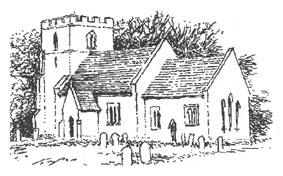History of Little Abington Church
by Patrick Daunt, Churchwarden
There has been a church on the present site for nearly one thousand years, as we can see from the main south door (nearly three feet thick) and the remains of an old entrance opposite. These are early Norman if not late Saxon, even though the population of the village in 1086 is recorded as no more than 20.
The original church would have ended with a round apse not far beyond the present screen. Then, in the thirteenth century when there were 35 tenants listed in the village, the church was extended to its present length, the new work being in the Early English style; we can see from the outside corners how some of the great stones from the first building were reused at that time. The north transept, the splendid font and the double piscina in the sanctuary belong to this extension, and the two arched recesses in the transept are likely to have housed monuments to the donors who sponsored it. It is interesting to see how the creator of all this planned to supplement the high altar with two side altars at the end of the nave, each with its own piscina set into the wall.
In the fourteenth century most of the tower was built, including the fine early Decorated west window and arched recess in the vestry. During that century and the next windows were enlarged or added in the nave and chancel -light became more important as more villagers were able to read. Yet it may not have been till later than this that the thatch of the roof was first replaced by tiles.
The most interesting personal monument in the church can be seen on the north wall of the chancel. It dates from the early seventeenth century and commemorates Oliver Dalton of West Wratting. Though it is in rather poor repair, we can still read the touching octave of verses which record his widow's love and sense of loss.
The bell, sole survivor of the three here in the eighteenth century, is the tenor of a peal and was made by Brian Ethridge in 1620.
Apart from the construction of a gallery at the west end (since of course removed) little except the installation of the excellent pews in the sixteen hundreds seems to have been done to improve the church during four hundred years; the insertion of heavily moulded windows in the transept and at the east end of the church hardly qualify as improvements.
Towards the end of the last century there were nearly 339 families living in Little Abington, which was then the bigger of the villages. Yet the church was, like so many others, in a poor state of repair.
Fortunately, the vicar of the day, Mr A.H.D. Hutton, decided to undertake at his own expense a comprehensive restoration in memory of his sister. The roof was completely restored inside and out, the vicar preserving as many of the old timbers as he could; his tiles and rafters are serving us well to this day. Nearly all the outside walls were repointed, the porch was completely rebuilt, the nave and chancel floors attractively tiled throughout, all the damaged pews replaced with creditable copies of the original ones and tactful renderings of Early English lancet windows substituted for the clumsy versions at the east end of the church. There is a brass plaque commemorating the vicar's work over the south door.
The family's generosity was extended to the next generation, the vicar's daughter sponsoring both the organ at the entrance to the transept and the fine Kempe window on the south wall of the sanctuary. Our churchyard is still 'open', that is, used as the burial ground for both villages, and there is a Garden of Remembrance for those who have been cremated.
Work to keep up the churchyard and the church itself goes on all the time; recently, for example, nearly the whole exterior has been repointed, the drainage vastly improved, the organ overhauled and the interior redecorated. For this and other work we owe our thanks to the many parishioners who have contributed most generously both to the cost and by their voluntary work.
For the Millennium we have restored the flagpole, designed and made a new kneeler for the altar rail and installed a commemorative stained glass window.


